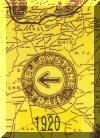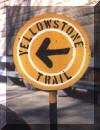
On The Road to Yellowstone
The Yellowstone Trail and American Highways 1900 - 1930
THIS WORK DEDICATED TO THE MEMORY OF HAROLD (HAL) MEEKS,
WHO PASSED AWAY DECEMBER 18, 2005
AFTER A SHORT BATTLE WITH CANCER.
 Ohio
Map. Founded in October 1912 at Lemmon, South Dakota, the Yellowstone
Trail is "America's Oldest Organized Highway." It predates the founding of
the Lincoln Highway by one year, although in its original form was not a
transcontinental route like the Lincoln. However, by 1920 the Yellowstone
Trail had become an ocean-to-ocean highway, crossing the northern part of the
United States as "A Good Road from Plymouth Rock to Puget Sound," or less
poetically, between Boston, Massachusetts and Seattle, Washington.
Forgotten in Ohio, the Yellowstone Trail passed through Ashtabula, Cleveland,
Lorain, Sandusky, Fremont, Toledo, and Bryan. A dirt road named
"Yellowstone Trail" near Hamlet, Indiana is the easternmost identification of
the old coast-to-coast route.
Ohio
Map. Founded in October 1912 at Lemmon, South Dakota, the Yellowstone
Trail is "America's Oldest Organized Highway." It predates the founding of
the Lincoln Highway by one year, although in its original form was not a
transcontinental route like the Lincoln. However, by 1920 the Yellowstone
Trail had become an ocean-to-ocean highway, crossing the northern part of the
United States as "A Good Road from Plymouth Rock to Puget Sound," or less
poetically, between Boston, Massachusetts and Seattle, Washington.
Forgotten in Ohio, the Yellowstone Trail passed through Ashtabula, Cleveland,
Lorain, Sandusky, Fremont, Toledo, and Bryan. A dirt road named
"Yellowstone Trail" near Hamlet, Indiana is the easternmost identification of
the old coast-to-coast route.
Natural sandstone pillars like this were planted along the Yellowstone Trail in South Dakota, North Dakota, and Montana. According to a 1913 article from the Aberdeen, South Dakota newspaper, "they measure from six to ten feet long, being from twelve to eighteen inches through at the base, and from six to eight inches at the top. They are ideal markers when painted yellow with the words 'Yellowstone Trail' painted on them." The only surviving marker with the classic obelisk shape has been moved to this street corner location in Hettinger, South Dakota.
 "A
twelve-inch band or circle with a six-inch black arrow" was the official mark of
the Yellowstone Trail, although there were also signs with "L" and "R" for
upcoming left and right turns. Founder Joseph W. Parmley had this
suggestion regarding the many different kinds of yellow paint: "Now the
very best yellow is the medium chrome yellow. Buy it dry; from thirteen to
sixteen cents a pound and mix linseed oil in it." Arrows painted on signs
pointed to Yellowstone National Park, which was reached by a spur road from
Livingston, Montana. This sign can be found now in the Dakota Buttes
Museum in Hettinger, North Dakota.
"A
twelve-inch band or circle with a six-inch black arrow" was the official mark of
the Yellowstone Trail, although there were also signs with "L" and "R" for
upcoming left and right turns. Founder Joseph W. Parmley had this
suggestion regarding the many different kinds of yellow paint: "Now the
very best yellow is the medium chrome yellow. Buy it dry; from thirteen to
sixteen cents a pound and mix linseed oil in it." Arrows painted on signs
pointed to Yellowstone National Park, which was reached by a spur road from
Livingston, Montana. This sign can be found now in the Dakota Buttes
Museum in Hettinger, North Dakota.
This painted yellow circle with black arrow is in Snoqualmie Pass, Washington, and author Hal Meeks speculated that it may be the sole surviving mark of a 1915 trail blazing trip by a Mr. Warwick. This mark was an upgrade over "simple splotches.
About the Author
Harold A. Meeks
 The
late Harold
Meeks was an Emeritus Professor of Geography at the University of Vermont.
His membership in the Lincoln Highway Association was partly responsible for his
interest in the Yellowstone Trail. The importance of the Lincoln Highway
and other named roads is a significant part of his book, with several
contemporary pictures included from Ohio. When not exploring the old named
trails of America, Hal and his wife Milly lived in Essex Junction, Vermont.
Hal died December 18, 2005 and will be greatly missed by his family, friends,
the Lincoln Highway Association, and old road fans across America.
The
late Harold
Meeks was an Emeritus Professor of Geography at the University of Vermont.
His membership in the Lincoln Highway Association was partly responsible for his
interest in the Yellowstone Trail. The importance of the Lincoln Highway
and other named roads is a significant part of his book, with several
contemporary pictures included from Ohio. When not exploring the old named
trails of America, Hal and his wife Milly lived in Essex Junction, Vermont.
Hal died December 18, 2005 and will be greatly missed by his family, friends,
the Lincoln Highway Association, and old road fans across America.
Copyright 2000 by Harold Meeks
PICTORIAL HISTORIES PUBLISHING CO., INC.
Missoula, Montana 59801
713 South Third West
Phone (406) 549-8488
Fax (406) 728-9280
e-mail: phpc@montana.com
ISBN No. 1-57510-079-7